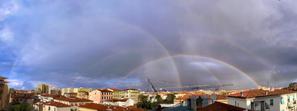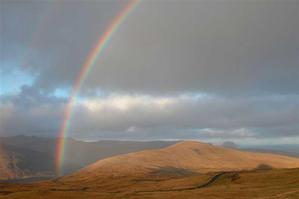Glossarbegriffe: Regenbogen
Description: Ein Regenbogen ist ein riesiger Bogen mit kreisbogenförmigen Streifen in den Farben Violett, Indigo, Blau, Grün, Gelb, Orange und Rot, der sich über den Himmel spannt und in der Regel nach einem Regenschauer zu sehen ist. Wenn ein Beobachter einen Regenbogen sieht, steht er oder sie mit dem Rücken zur Sonne. Ein Regenbogen entsteht, weil die kleinen Wassertröpfchen in der Luft das weiße Sonnenlicht in seine einzelnen Farben zerlegen: Dieses Phänomen wird auch Dispersion des Lichts durch Brechung genannt. Ein Prisma funktioniert auf ähnliche Art und Weise. Bei einem normalen Regenbogen wird das Licht einmal in den Wassertröpfchen reflektiert und zusätzlich durch Brechung in seine Farben aufgespalten.
Manchmal ist über einem Regenbogen ein zweiter Regenbogen zu sehen, wobei die Farben dieses zweiten Regenbogens in umgekehrter Reihenfolge angeordnet sind. Der innere, hellere Regenbogen wird als Hauptregenbogen bezeichnet. Der äußere, weniger intensive Regenbogen darüber wird als Nebenregenbogen bezeichnet. Dieses Phänomen des doppelten Regenbogens ist relativ selten. Der Nebenregenbogen entsteht, wenn das Licht in den Wassertröpfchen zusätzlich zur Brechung zweimal reflektiert wird.
Zugehörige Glossarbegriffe:
See this term in other languages
Term and definition status: The original definition of this term in English have been approved by a research astronomer and a teacher The translation of this term and its definition is still awaiting approval
The OAE Multilingual Glossary is a project of the IAU Office of Astronomy for Education (OAE) in collaboration with the IAU Office of Astronomy Outreach (OAO). The terms and definitions were chosen, written and reviewed by a collective effort from the OAE, the OAE Centers and Nodes, the OAE National Astronomy Education Coordinators (NAECs) and other volunteers. You can find a full list of credits here. All glossary terms and their definitions are released under a Creative Commons CC BY-4.0 license and should be credited to "IAU OAE".
If you notice a factual or translation error in this glossary term or definition then please get in touch.
Zugehörige Medien
24 Hours of Rainbow
Bildnachweis: Fabrizio Guasconi/IAU OAE (CC BY 4.0)
License: CC-BY-4.0 Creative Commons Namensnennung 4.0 International (CC BY 4.0) icons
Related Activities
Reading the Rainbow
astroEDU educational activity (links to astroEDU website) Description: By understanding how rainbows work, you can discover about light and its properties, learning about stars, nebulae, galaxies, and our Universe.
License: CC-BY-4.0 Creative Commons Namensnennung 4.0 International (CC BY 4.0) icons
Age Ranges:
14-16
, 16-19
, 19+
Education Level:
Informal
, Middle School
, Secondary
, University
Areas of Learning:
Interactive Lecture
, Observation based
, Social Research
Costs:
Low Cost
Duration:
1 hour 30 mins
Group Size:
Group
Skills:
Analysing and interpreting data
, Asking questions
, Engaging in argument from evidence










